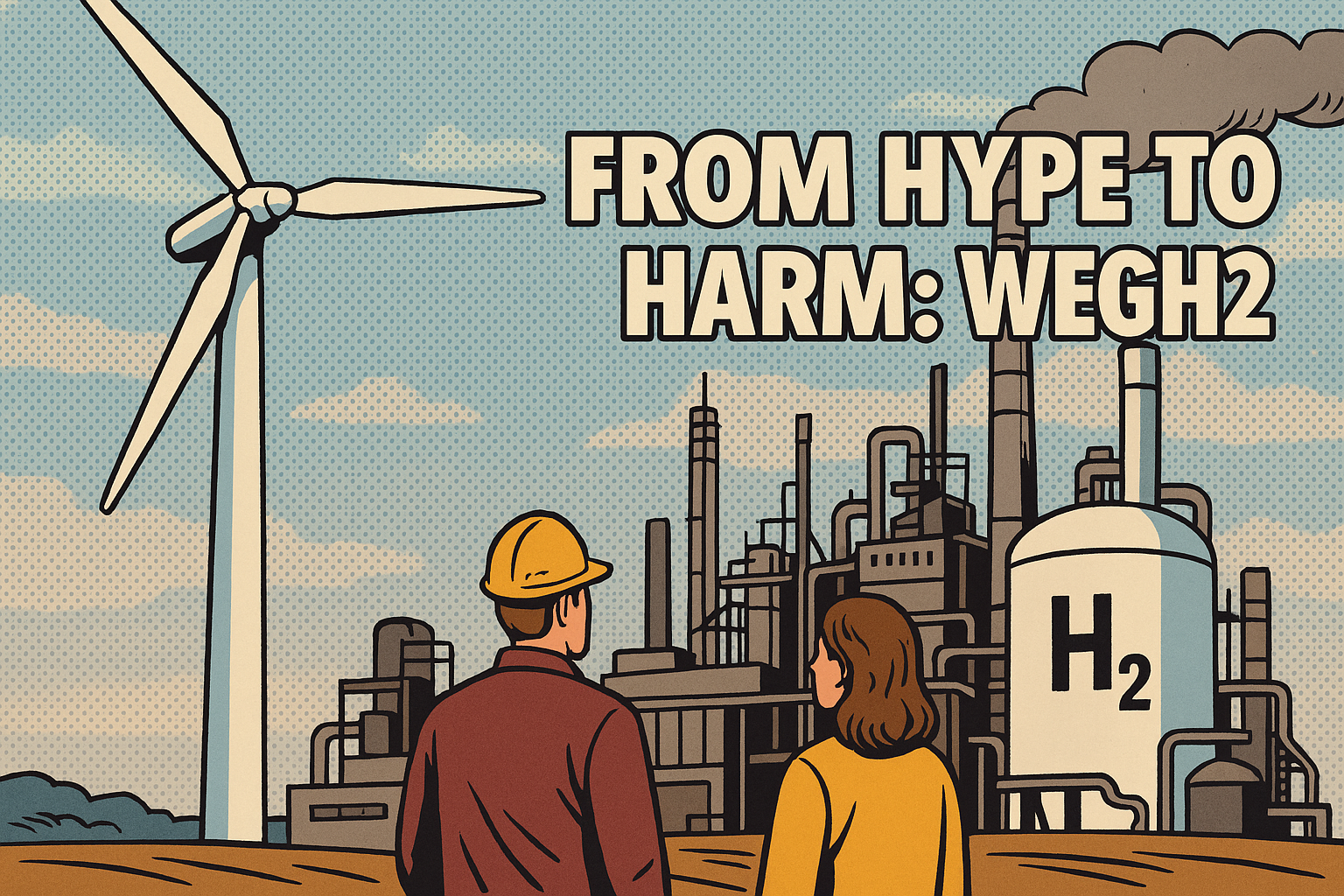When the World Energy GH2 (WEGH2) megaproject was announced, it was marketed as Newfoundland’s entry ticket to the clean-energy future. Politicians and corporate leaders staged photo-ops with German officials, promising thousands of jobs and billions in investment. For many, it felt like déjà vu. Newfoundland and Labrador has seen this cycle before: the cod fishery, Churchill Falls, Muskrat Falls, Shale Oil on the West Coast. Each was sold as economic salvation. Each left behind its own reckoning.
The Hype Cycle Returns
The cod fishery collapse in 1992 devastated coastal communities, putting over 30,000 people — 12% of the labour force — out of work¹. That collapse was more than an economic crisis; it was an existential shock for outport communities built on generations of fishing culture. Families uprooted, outmigration surged, and trust in both government and science fractured. This legacy lingers in public memory, shaping how residents evaluate every new project. Hogan describes this stance as “sceptical optimism” — a willingness to support renewable projects, but always through the lens of past betrayals¹.
Hydroelectric power followed the same trajectory. Churchill Falls, signed in the 1960s, locked NL into a contract selling 5,428 MW to Hydro-Québec at rates “barely distinguishable from being free” until 2041². It became the textbook example of a deal that transferred wealth out of the province while locking locals into resentment. Muskrat Falls was meant to “correct” that imbalance, but instead became a cautionary tale of its own. The $12.7 billion overrun was not a technical inevitability; it was the result of what the Commission of Inquiry later called “frequently unprincipled steps” taken by executives and decision-makers to push the project through³.
Oil and gas added yet another boom-bust chapter. Offshore development was hailed as salvation in the 1990s, and for a time it delivered. By 2007, oil contributed 35% of provincial GDP. But the volatility of global prices soon erased those gains. By 2016, unemployment had climbed to 14.4%, proof that dependence on a single volatile sector leaves the province perpetually vulnerable⁴.
Now, WEGH2 is positioned as the next saviour. Hydrogen was branded as inevitable progress — the “green replacement for oil.” Federal leaders staged joint announcements with Germany in Stephenville, presenting it as an international alliance and a generational turning point⁵. Yet, as with cod, hydro, and oil, the hype rests on fragile assumptions: global demand, market subsidies, and long-term export feasibility.
Weak Councils, Strong Promises
One reason hype cycles take hold so easily is the structural weakness of municipal governance. Newfoundland and Labrador’s municipalities are chronically underfunded and operate under what economists call soft budget constraints. Small tax bases, high per-capita service costs, and a province that routinely bails out deficits create an environment where local councils learn that prudence rarely pays off. If the province will rescue them anyway, better to gamble on the next promised industry⁶.
This dependency has consequences. When multinational corporations arrive promising jobs and tax revenue, councils lack leverage to negotiate strict conditions. They are forced into the role of cheerleaders rather than watchdogs. Instead of asking whether the project serves the community’s long-term interests, councils often rally behind it in hopes of securing short-term fiscal relief.
Silencing the Critics
The hype stage of WEGH2 was also marked by the narrowing of public debate. Residents who raised questions about turbine density, Crown land allocations, or the speculative nature of the hydrogen market often found themselves isolated. In small communities, reputations are fragile; to speak against a project branded as “the future” could mean being labelled anti-progress, or even disloyal to the region.
This is how manufactured acceptance works. On paper, surveys showed high levels of support for wind projects — sometimes reported as 76–100% acceptance¹. But Hogan’s interviews revealed a different reality: people filtered these projects through a history of failed promises and broken institutions. Support was conditional, skeptical, and layered with distrust. Yet these nuances rarely entered the official consultation record. Critics’ voices remained in whisper networks, never formalized, never counted (Brad Cabana and Andrew Abbass are the perfect examples of this).
From Hype to Harm
By 2025, cracks in the hydrogen hype had already begun to show. The global market cooled, with delays in infrastructure and questions over transport costs. Yet in Newfoundland, the land had already been committed. The province’s Crown Land Call for Bids framework allocated vast tracts of public land for industrial hydrogen export⁷. Communities suddenly faced restrictions on traditional land use, without having seen a single promised benefit.
This is the harm stage. Just as Muskrat Falls left households with higher power rates and deeper distrust of institutions³, and just as the cod collapse left rural towns depopulated and fractured¹, WEGH2 risks leaving behind stranded land and another cycle of disillusionment.
The harm, however, is not just local. Newfoundland’s cycle of hype-to-harm echoes global patterns in resource peripheries. From Appalachia’s coal towns to the North Sea oil platforms, promises of prosperity often mask long-term dependence and environmental scars. Newfoundland’s experience is sharper because the province has repeated the cycle so many times in living memory. That repetition compounds harm: skepticism hardens into cynicism, and cynicism undermines both governance and the possibility of genuine innovation.
Breaking the Cycle
The reckoning Newfoundland needs goes beyond WEGH2. It requires confronting the deeper pattern of selling megaprojects as salvation while ignoring the lessons of history. Breaking that cycle demands:
- Governance with teeth: Local councils must be equipped and empowered to act as regulators, not passive dependents. Without fiscal independence, they will always be prone to megaproject seduction.
- Transparency in land use: Crown lands should not be allocated under crisis-driven narratives or closed-door arrangements. A clear, public process is the only way to rebuild trust.
- Space for dissent: Criticism should be recognized as a sign of democratic health, not dismissed as obstruction.
The lesson is not that Newfoundland should abandon large projects. It is that the province must build the institutional strength to engage with it on its own terms, not as a desperate supplicant to outside investors. Without such changes, companies such as WEGH2 risks becoming just another entry in the province’s long ledger of hype and harm — a cycle that has stretched from cod, to hydro, to oil, and now, to hydrogen.
See also
- When the Fire Is the Excuse
- Governance Without Teeth
- The Whisper Network
- Rehearsed Truth: How Repeating the Same Story Keeps Newfoundland Stuck
- Leverage as Currency in Newfoundland Politics
- Behind the Green Curtain
- Imported Outrage, Local Silence
- Silence by Design
References
[1] Hogan, J. (2025). The Legacy of the Cod Fishery Collapse: Understanding Wind Energy Acceptance in Newfoundland through Energy Justice and Place. Energy Research & Social Science, 127, 104274. https://doi.org/10.1016/j.erss.2025.104274 (Local Download)
[2] Bavington, D. (2010). Managed Annihilation: An Unnatural History of the Newfoundland Cod Collapse. UBC Press.
[3] Bannister, J. (2012). A River Runs Through It: Churchill Falls and the End of Newfoundland History. Acadiensis, 41(1), 211–225. https://journals.lib.unb.ca/index.php/Acadiensis/article/view/19083
[4] LeBlanc, R.D. (2020). Muskrat Falls: A Misguided Project. Commission of Inquiry. https://www.muskratfallsinquiry.ca/
[5] Macleans. (2016). Bust Times Are Back in Newfoundland and Labrador. https://macleans.ca/economy/bust-times-are-back-in-newfoundland-and-labrador/
[6] CBC News. (2023). Canada, Germany sign hydrogen alliance in Stephenville. https://www.cbc.ca/news/canada/newfoundland-labrador/canada-germany-hydrogen-partnership-nl-1.6559787
[7] NL Government. (2023). Guidelines: Crown Lands Call for Bids for Wind Energy Projects. https://www.gov.nl.ca/iet/files/Guidelines-Crown-Land-Call-for-Bids-for-Wind-Energy-Projectsrev-121-Mar-3-2023.pdf
[8] Guo, X. (2025). Optimal Transfer Mechanism for Municipal Soft-Budget Constraints in Newfoundland. https://arxiv.org/abs/2508.02171v3 (Local Download)
[9] Huber, M. (2013). Lifeblood: Oil, Freedom, and the Forces of Capital. University of Minnesota Press.
[10] Roberts, T. (2025). N.L.’s wind-hydrogen hype is on fumes, but this Placentia Bay project is forging ahead. CBC. https://www.cbc.ca/news/canada/newfoundland-labrador/wind-hydrogen-placentia-bay-1.7503543

